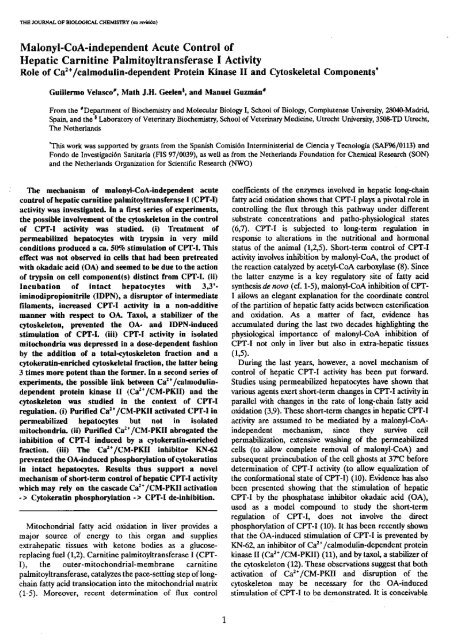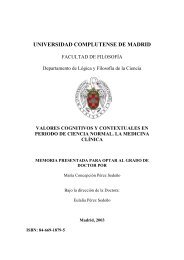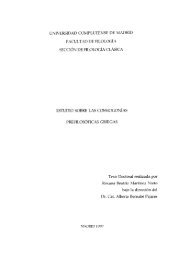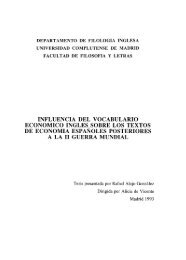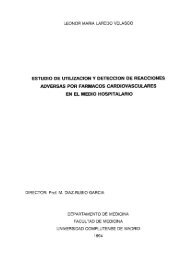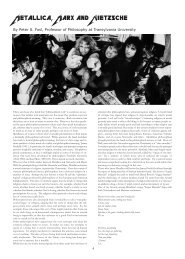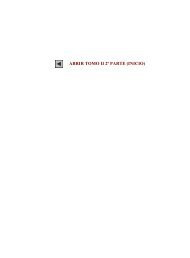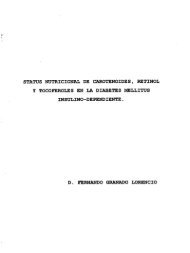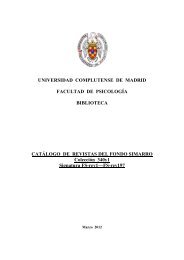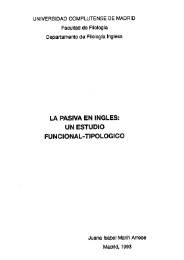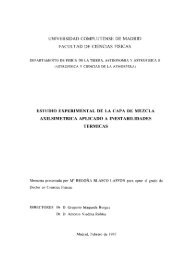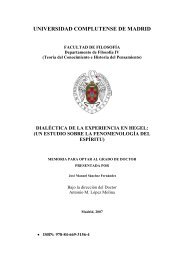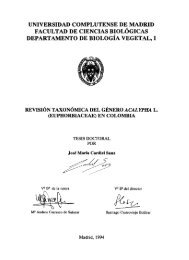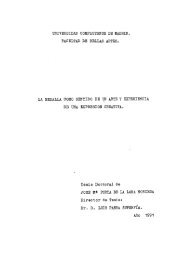liiiMIIIfl~UDliiiMIII~U - Biblioteca de la Universidad Complutense ...
liiiMIIIfl~UDliiiMIII~U - Biblioteca de la Universidad Complutense ...
liiiMIIIfl~UDliiiMIII~U - Biblioteca de la Universidad Complutense ...
You also want an ePaper? Increase the reach of your titles
YUMPU automatically turns print PDFs into web optimized ePapers that Google loves.
THE JOURNAL OP WOLOGICAL CI4EM¡SIRY (en revisión)<br />
Malonyl-CoA-in<strong>de</strong>pen<strong>de</strong>nt Acute Control of<br />
Hepat¡c Carnitine Palmitoyltransferase 1 Activity<br />
Role of Ca2~/ca1moduIin-<strong>de</strong>pen<strong>de</strong>nt Protein K¡nase II aud Cytoskeletal Component?<br />
Guillermo Ve<strong>la</strong>scot, Math J.H. Geelen, and Manuel Guzmánt<br />
From the ‘~Department of Biochemistry and Molecu<strong>la</strong>r Biolo~r 1, School of Bio)o~’, <strong>Complutense</strong> University, 28040-Madrid,<br />
Spain, and the ‘ Laboratory of Veíerina¡y Biochemistry, Schooi of Veterinaay Medicine, Utrecht University, 3508-TD Utrecht,<br />
The Netheriands<br />
This work was supported by granrs froan the Spanish Comisión Interministerial <strong>de</strong> Ciencia y Tecnología (SAF9Ó/O113) arad<br />
Fondo <strong>de</strong> Investigación Sanitaria (FIS 97/0039), as well as fror» the Ncthcr<strong>la</strong>nds Foundation for Chemical Research (SON)<br />
and the Netheriands Organization for Sciantific Research (NWO)<br />
-The mechanism of malonyl-CoA-in<strong>de</strong>pen<strong>de</strong>nt acate<br />
control of hepatie carn¡tine palmitoyltransferase 1 (CP’T-I)<br />
acrivity was investigated. In a first series of experiments,<br />
the possible involvement of the cytoskeleton in the control<br />
of CI’T-1 activity was studied (1) Treatment of<br />
pe¡-meabllized hepatocytes with tryps¡n ¡u very mild<br />
conditions produced a ca. 50% stimu<strong>la</strong>tion of CPT-1. This<br />
effect was not observed in celis that bad been pretreated<br />
with okadaic acid (QA) and seemed to be due to tbe action<br />
of tryps¡n 00 cdl component(s) distinct from CPT-I. (u)<br />
Incubation of ¡ntact bepatocytes with 3,3’-<br />
iminodipropionitrile (IDPN), a disruptor of intermediare<br />
fi<strong>la</strong>ments, ¡nci-eased CPT-1 activity in a non-addit¡ve<br />
manner with respect to OX Taxol, a stabiiizer of tbe<br />
cytoskeleton, prevented the QA- and IDPN-induced<br />
stimu<strong>la</strong>tlon of CPT-l. (iii) CPT-I activity iii iso<strong>la</strong>ted<br />
mitochondria ns <strong>de</strong>pressed ¡o a dose-<strong>de</strong>pen<strong>de</strong>nt fashion<br />
by the addition of a total-cytoskeleton fraction and a<br />
cytokeratin-enriched cytoskeletal fraction, tbe <strong>la</strong>trer be¡ng<br />
3 times more potent than the former. lo a second series of<br />
experiments, tbe poss¡ble link between Ca2~/calmodulin-<br />
<strong>de</strong>pen<strong>de</strong>nt protein kinase 11 (Ca2/CM-PKII) and the<br />
cytoskeleton ii-as stud¡ed in the contefl of CFI’-1<br />
regu<strong>la</strong>tion. Cytokeratin phosphory<strong>la</strong>tion -> CPT-1 <strong>de</strong>-inhibition.<br />
Mitochondrial fatty acid oxidation in livor provi<strong>de</strong>s a<br />
major sourco of energy Lo this organ and supplios<br />
extrahepatic tissuos with ketone bodios as a glucose-<br />
rep<strong>la</strong>cing fuel (1,2). Carnitino palmitoyltransforase 1 (CFI’-<br />
1), the outer-mitochondrial-menibrano carnitino<br />
pa]mitoyltransforaso, catalyzos the pace-sotting stop of long-<br />
chain fatty acid translocation hito dio mitochondrial matrix<br />
(1-5). Moreovor, receut <strong>de</strong>termination of flux control<br />
1<br />
coefficients of the enzymes involved in hepatic iong-chain<br />
fatty acid oxidation shows that CPT-I p<strong>la</strong>ys a pivotal role in<br />
controlling tho flux through tbk patbway undor different<br />
substrato concontrations and patho-physiological ataros<br />
(6,7). CPT-I is subjectod Lo long-torm rogu<strong>la</strong>tion lii<br />
responk to altorations in tho nutrirional aud hormonal<br />
status of tSe animal (1,2,5). Short-term control of CPT-I<br />
acdvity involves inhibition by malonyl-CoA, the product of<br />
the roaction catalyzed by acetyl-CoA carboxy<strong>la</strong>se (8). Since<br />
tho <strong>la</strong>ttor onzyme ja a koy regu<strong>la</strong>tory site of fatty acid<br />
synthosis <strong>de</strong> novo (cf. 1-5), malonyl-CoA inhibition of CFI’-<br />
1 allows an elegant expianation for tho coordinato control<br />
of tho partition of hepatic fatty acids betweon ostorification<br />
and oxidation. As a matror of fact, ovidonce has<br />
accumu<strong>la</strong>ted during tSe <strong>la</strong>sÉ two docados highlighting tSe<br />
pbysiological importanco of malonyi-CoA inhibition of<br />
CPT-I not only in livor bur also iii extra-hopatic tissues<br />
(1,5).<br />
During tho <strong>la</strong>sÉ years, howovor, a novel mochanism of<br />
control of hepatic CPT-I activity has beon pur forward.<br />
Srudios using permeabilizod hopatocytos hayo shown that<br />
varinus agonts oxort short-torm changos ¡u CP’I’-I activity iii<br />
parallol with changos ¡u tho rato of long-chain fatty acid<br />
oxidation (3,9). Thoso shorr-rerm changos ira bopatio CPT-l<br />
activity are asaumed to be mediatod by a malonyl-CoAindopen<strong>de</strong>nt<br />
mochanism, since they survive cd<br />
pormabilization, extensivo washing of tSe permoabilizod<br />
celis «o aliow complote reoñoval of malonyl-CoA) and<br />
subsequont proincubation of tho coil ghosts at 3TC before<br />
<strong>de</strong>tormination of CPT-I activity (to allow equalization of<br />
tho conformational atate of CPT-I) (10). Evidonco has also<br />
boen prosontod showing thaÉ the stimu¡ation of hepatic<br />
CPT-I by tSe phosphataso inhibitor okadaic acid (OA),<br />
used as a modol compound to study tho shorr-torm<br />
rogu<strong>la</strong>tion of CPT-I, doca nor involvo tho direct<br />
phosphoryiation of CPT-I (10). It has been rocontly shown<br />
that tSe OA-inducod stimu<strong>la</strong>tion of CPT-I ¡a prevented by<br />
KN-62, an inhibitor of Ca2~/cahnodulin-<strong>de</strong>pendont protoin<br />
kinase II (Ca2~/CM-PKII) (11), aud by taxol, a atabilizer of<br />
the cyroskeleton (12). These obsorvations suggost that both<br />
activation of Ca2~/CM-PKII aud disruption of tho<br />
cytoskoloton may be nocossary for the QA-induced<br />
stimu<strong>la</strong>tion of CPT-I Lo be <strong>de</strong>monstrated. It os conceivable


